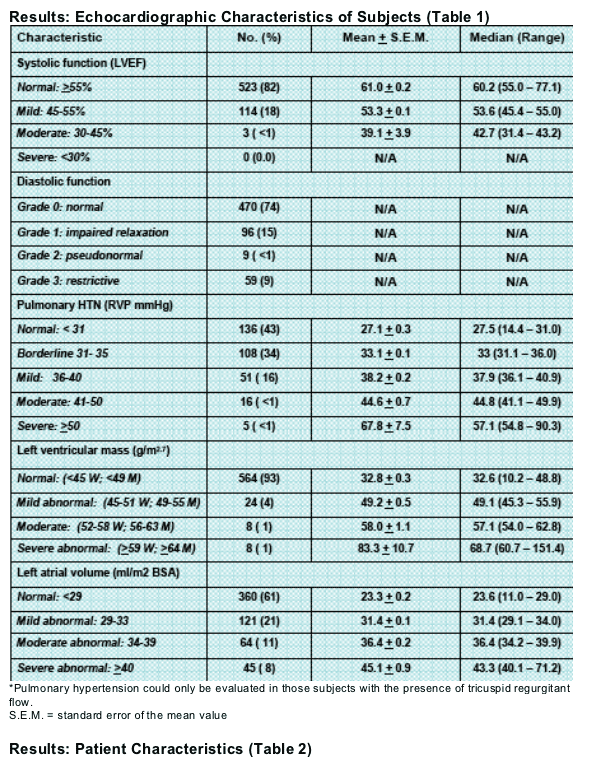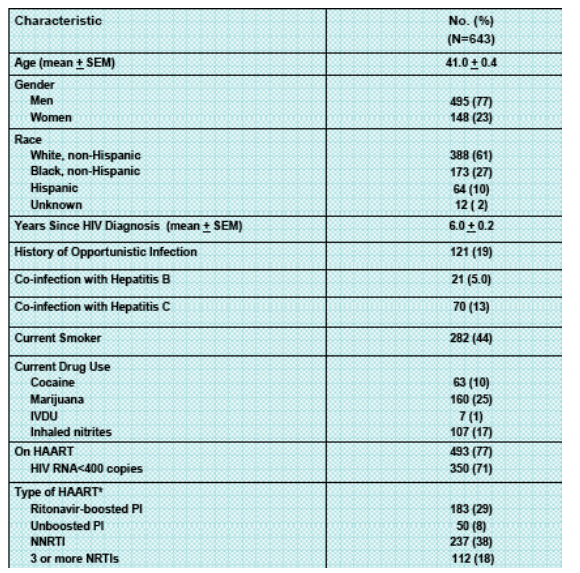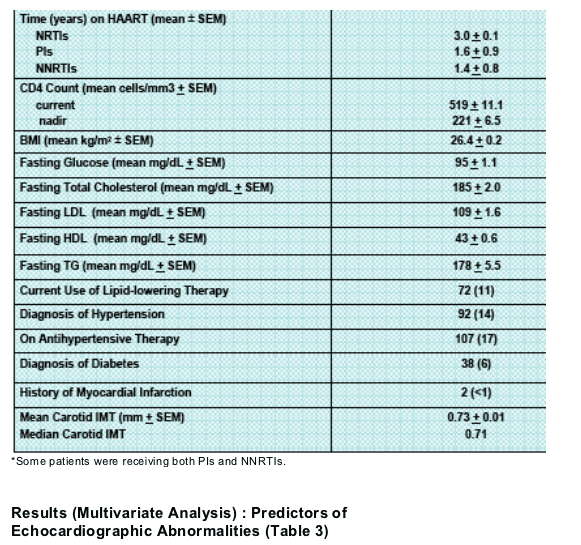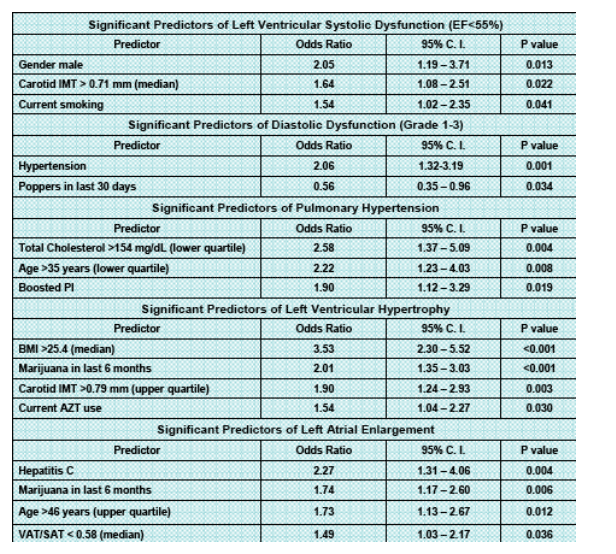| |
Prevalence and Risk Factors in HIV-infected Persons for Echocardiographic Abnormalities in the Era of Modern HAART
|
| |
| |
Reported by Jules Levin
15th CROI, Feb 2008, Boston
K Mondy1, J Gottdiener2, ET Overton1, K Henry3, L Conley4,T Bush4, J Hammer5, C Carpenter6, EM Kojic6, JT Brooks4, and SUN Study Investigators
1Washington Univ Sch of Med, St Louis, MO, US; 2 Univ of Maryland, Baltimore, Maryland, US; 3HIV Program, Hennepin County Med Ctr, Univ of Minnesota, MN, US; 4CDC, Atlanta, GA, US; 5Denver Infectious Disease Consultants , Denver, US; 6The Miriam Hosp, Providence, RI, US
AUTHOR CONCLUSIONS
In the era of modern HAART, subtle abnormalities in cardiac function were prevalent within this patient cohort.
Echocardiographic abnormalities were predicted not only by traditional cardiac risk factors but also modifiable risk factors including illicit drug use.
Of the ARV therapy evaluated, the only associations were current use of ritonavir-boosted PIs with pulmonary hypertension and current AZT use with left ventricular hypertrophy.
The current analysis suggests lifestyle modification should be a high priority in the management of chronic HIV disease.
Further longitudinal assessment of cardiac function is anticipated in this HIV-infected cohort to determine whether these cardiac abnormalities remain stable over time.
ABSTRACT (updated)
Background: Cardiac function among HIV-infected persons in the contemporary treatment era has not been well characterized.
Methods: The SUN Study is a prospective cohort of 682 HIV-infected patients receiving care at clinics in Denver, Minneapolis, Providence, and St. Louis. At baseline, all patients underwent standardized echocardiographic examination. Using multivariate logistic regression modeling, we identified independent predictors of left ventricular systolic dysfunction (LVSD = ejection fraction <55%), diastolic dysfunction (DD), pulmonary hypertension (PHTN = right ventricular systolic pressure >30 mmHg), and LV hypertrophy (LVH = LV mass >45 (women) and >49 (men) g/m2).
Results: Characteristics for 643 subjects with available data were: median age 41 years, 23% women, 27% Black, mean body mass index (BMI) 26.4 kg/m2, 77% on HAART, mean CD4 cell count (CD4) 519 cell/_L, 54% with HIV viral load <400 copies/mL, 14% hypertensive, 6% diabetic, 44% smokers.
Eighteen percent of 640 evaluable subjects had LVSD (111 [18%] mild, 3 [<1%] moderate, 0 severe), 25% of 660 evaluable subjects had DD (96 [15%] grade 1 [G1], 9 [<1%] G2, 59 [9%] G3), 22% of 316 evaluable patients (i.e., had any tricuspid regurgitant flow present) had Pulm HTN (51 [16%] mild, 16 [<1%] moderate, 5 [<1%] severe), 6.6% of 604 evaluable subjects had LVH (24 [4%] mild, 8 [1%] each moderate and severe).
Multivariate analyses demonstrated the following independent associations: for LVSD - male gender (odds ratio [OR] 2.1), carotid intima-media thickness [IMT] (OR 1.6 if >0.71 mm [median value]), and smoking (OR 1.5); for DD - HTN (OR 2.1), and use of inhaled nitrites (OR 0.6); for Pulm HTN - Total Cholesterol (OR 2.6 if >154mg/dL [1st quartile]), Age > 35 years (O.R. 2.2), and current use of a boosted PI (O.R. 1.9); and for LVH - body mass index (OR 3.5 if >25.4 [median value]), use of marijuana (OR 2.0) IMT (OR 1.9 if >0.79 mm [upper quartile]), and current AZT use (OR 1.5) (p<0.05 for all).
Conclusions: In this cohort of contemporary HAART-era patients, subclinical abnormalities in cardiac function were detected frequently. Functional abnormalities were mostly associated with expected and often modifiable risks. Our analysis suggests lifestyle modification should become a greater priority in the management of chronic HIV disease.
BACKGROUND
The natural history of HIV infection has been associated with a diverse array of adverse metabolic complications that may increase the risk of developing cardiovascular disease and accelerate risk of other diseases.
The Study to Understand the Natural History of HIV/AIDS in the Era of Effective Therapy (eSUN' Study) is a prospective cohort study designed to examine risk factors for complications of treating HIV infection and longer survival.
Patients are followed from 7 clinics in 4 U.S. cities-Minneapolis, Denver, St Louis, Providence.
The primary objectives of this analysis were to characterize baseline cardiac function of subjects by modern echocardiographic methods and to determine clinical, behavioral, and laboratory predictors of prevalent echocardiographic abnormalities.
METHODS
SUN Study Subjects: Age >18, either ARV-naive with CD4 cell count 100-500 cells/mm3 or HAART-experienced with CD4 cell count >100 cells/mm3; no immunomodulating therapy or AIDS-defining illness in 60 days preceding baseline enrollment.
Methods/Data Collection: Baseline resting echocardiography with tissue doppler imaging, carotid intima media thickness, patient demographics, behavioral risk factors, and fasting laboratory data were analyzed for the SUN cohort (n=667, tables 1-2); subgroup analyses were performed for the following
echocardiographic abnormalities: left ventricular systolic dysfunction, diastolic dysfunction, pulmonary hypertension, and left ventricular hypertrophy. Sources of data included anonymous patient interview and laboratory data obtained at baseline study visit as well as abstraction of data from outpatient medical records. Echocardiographic and carotid data were read at central reading sites (U. of Maryland, Baltimore and U. of Southern California, respectively).
Statistics: Chi-square or Fisher's exact tests were used for categorical variables. Continuous variables were compared using the Student's t-test or Mann-Whitney U test. Multivariate logistic regression were used to identify independent predictors of echocardiographic outcomes from among factors significant in univariate analyses. All p values were two-tailed. Analysis was performed using SAS software version 9.1.




|
|
| |
| |
|
|
|